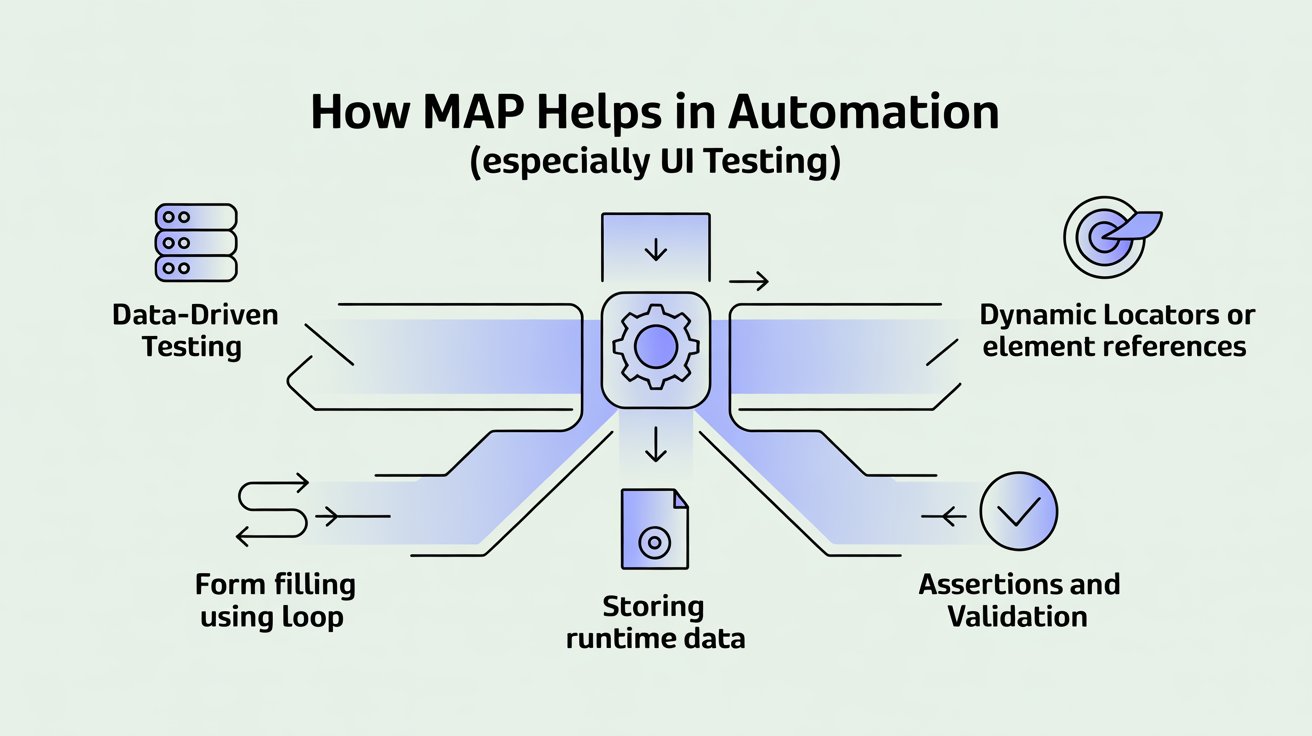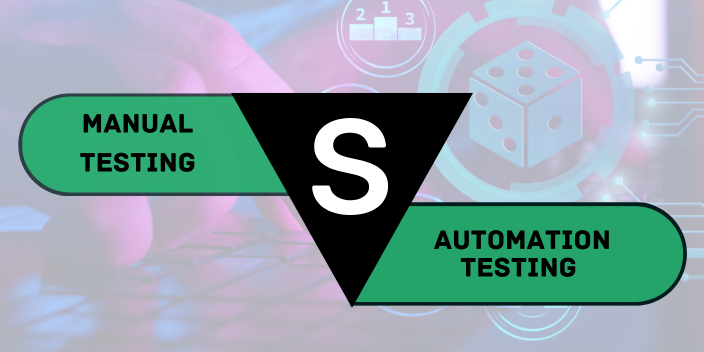Introduction
As automation testers, we deal with vast amounts of structured data — form inputs, expected results, configurations, and more. While collections like List and Set are useful, have you ever found yourself struggling to map test data clearly, especially when working with labels and values or field names and inputs?
That’s where the Map interface in Java becomes a hidden hero — offering a cleaner, more intuitive way to represent and process test data in automation frameworks.
In this blog, we’ll reveal why Map is often a better fit than List or Set when designing robust and scalable automation test scripts.
What is a Map in Java?
A Map in Java is part of the Java Collections Framework and is designed to store key-value pairs, where each key is unique and maps to exactly one value. Unlike Lists or Sets, a Map is perfect when you need fast lookups and organized data mapping. In Selenium automation, a Map can hold element locators as keys and XPath or CSS selectors as values, enabling quick updates without modifying multiple scripts.
| Concept | Example |
| Key | “username” |
| Value | “testleafuser” |
| Key | “password” |
| Value | “Welcome123” |
Unlike a List (which uses index-based access) or a Set (which only stores unique values), a Map allows you to represent relationships between data elements.
Popular Articles: automation testing interview questions
How Map Helps in Automation (Especially UI Testing)
Using Map in test automation, especially with tools like Selenium, makes your code more scalable, readable, and maintainable.
1. Data-Driven Testing
Store test data like input values, expected results, or element locators:
Map<String, String> testData = new HashMap<>();
testData.put(“Name”, “Bhuvanesh”);
testData.put(“Email”, “bhuvan@test.com”);
driver.findElement(By.id(“name”)).sendKeys(testData.get(“Name”));
driver.findElement(By.id(“email”)).sendKeys(testData.get(“Email”));
Why? Easy to iterate or load from Excel/CSV/property files using key-value pairing.
2. Dynamic Locators or Element References
Instead of hardcoding locators everywhere:
Map<String, By> locators = new HashMap<>();
locators.put(“loginButton”, By.id(“login”));
locators.put(“searchBox”, By.name(“q”));
driver.findElement(locators.get(“loginButton”)).click();
Keeps all your locators in one place = better maintainability.

3. Form Filling Using Loop
Map<String, String> formFields = new HashMap<>();
formFields.put(“username”, “admin”);
formFields.put(“password”, “pass123”);
for (Map.Entry<String, String> entry : formFields.entrySet()) {
driver.findElement(By.id(entry.getKey())).sendKeys(entry.getValue());
}
Saves repetitive code — helps scale test cases.
4. Storing Runtime Data
Fetch and store data from UI or API for later use:
Map<String, String> uiData = new HashMap<>();
uiData.put(“orderId”, driver.findElement(By.id(“order_id”)).getText());
uiData.put(“status”, driver.findElement(By.id(“order_status”)).getText());
5. Assertions and Validation
Map<String, String> expectedValues = new HashMap<>();
expectedValues.put(“status”, “Active”);
Map<String, String> actualValues = new HashMap<>();
actualValues.put(“status”, driver.findElement(By.id(“status”)).getText());
Assert.assertEquals(actualValues.get(“status”), expectedValues.get(“status”));
Makes validations clean, readable, and maintainable.
Real-Time Testing Use Cases
| Use Case | Why Map Works Best |
| Filling dynamic forms | Map field name (key) to input (value) |
| Reading configuration files | .properties files are basically Maps |
| Expected vs actual validations | Map element label to expected text |
| User credentials per role | Role as key, login data as value |
The Power of entrySet() in Selenium Tests
Want to loop through all the form fields and enter data? entrySet() comes to the rescue:
for (Map.Entry<String, String> entry : formData.entrySet()) {
driver.findElement(By.name(entry.getKey())).sendKeys(entry.getValue());
}
With this single loop, you’re:
- Selecting elements dynamically using field names
- Sending inputs without hardcoding locators
- Making your code reusable across different test scenarios
Map vs List vs Set: At a Glance
| Feature | List | Set | Map |
| Stores duplicate values | ✅ | ❌ | ✅ (values only) |
| Maintains order | ✅ | ❌ | ❌ (unless LinkedHashMap) |
| Key-Value structure | ❌ | ❌ | ✅ |
| Ideal for UI field mapping | ❌ | ❌ | ✅ |
| Supports fast lookup by key | ❌ | ❌ | ✅ |
| Best for structured test data | ❌ | ❌ | ✅ |
Bonus Tip: Chaining Maps for Complex Data
Map<String, Map<String, String>> userData = new HashMap<>();
Map<String, String> adminData = new HashMap<>();
adminData.put(“username”, “admin”);
adminData.put(“password”, “admin123”);
userData.put(“Admin”, adminData);
This makes it easy to manage role-based credentials, configurations, or multi-level test data structures — all in one place.
Conclusion
In automation testing, clarity and maintainability are everything. While List and Set are great for storing collections of values, they fall short when it comes to mapping relationships — and this is where Map truly excels, especially when working with Java for Selenium.
By using Map in your test scripts, you:
- Reduce boilerplate code
- Increase script reusability
- Gain more control over dynamic data
Next time you build a test case that involves field names, labels, values, or configurations — remember:
If it pairs together, it belongs in a Map!
FAQs
Q1. What is a Map in Java and why is it useful in automation testing?
A Map in Java stores key-value pairs, allowing quick data retrieval. In automation, it helps manage locators, test data, and configurations efficiently.
Q2. How does Map improve Selenium automation scripts?
By centralizing element locators and test data, a Map reduces code duplication, makes updates easier, and improves script maintainability.
Q3. What are real-world use cases of Map in test automation?
Maps are used for storing dynamic locators, API request parameters, environment-specific URLs, and AI-generated test data.
Q4. What is the difference between Map, List, and Set in Java?
List allows duplicates, Set does not, and Map stores unique keys with corresponding values—ideal for mapping test data.
Q5. How can AI be integrated with Map in automation testing?
AI can generate synthetic test data dynamically, which can be stored in a Map for quick, reusable access in automated test scripts.
Author’s Bio:

As a Senior SDET with 8+ years in testing and development, I build scalable automation platforms ensuring quality at speed. Passionate about mentoring and innovation, I equip teams with real-time solutions and high-impact frameworks, driving excellence through continuous learning. Let’s shape the future of quality engineering together.
Dilipkumar Rajendran
Senior SDET | Playwright & Selenium Expert








